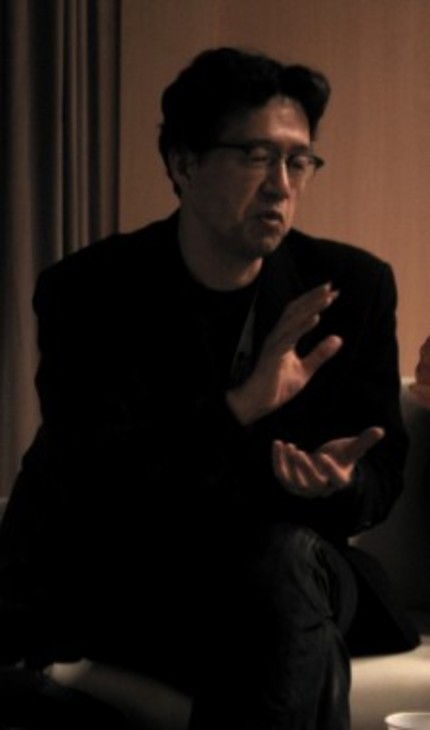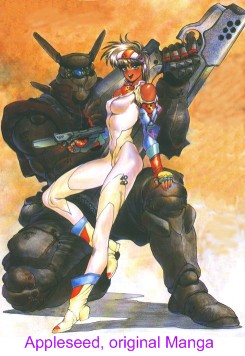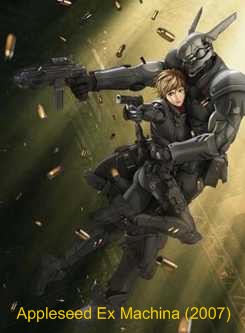IFFR 2008: Interview with "Appleseed: Ex Machina" director ARAMAKI SHINJI

This year at the International Film Festival Rotterdam we poor otaku faced a dearth of Japanese anime: there really was only one title which qualified as such. Thankfully that was "Appleseed: Ex Machina" and it turned out to be both good and spectacular, earning its audience rating of 4.0 (out of 5).
With great pleasure Peter van der Lugt (of GhibliWorld.com fame) and myself were able to interview the director of both Appleseed movies, Aramaki Shinji. Our meeting was graciously allowed to run overtime so we were able to cover several subjects like development, planning and even box office expectations.
After introducing ourselves and the obligatory three seconds of uneasy silence we launched straight into question one...
Read on after the break!
AV : You said in the past that after the first "Appleseed" you wanted to reach a different audience with "Appleseed: Ex Machina". Specifically you said that Otaku (anime fans) would show up anyway, so you could concentrate on making this one more accessible to the "Prada and Hollywood" crowd. How did you work this idea into the movie?
Aramaki-san: I made the first Appleseed specifically with anime fans in mind, but probably because of the use of computer-graphics and 3D we drew a far bigger audience than we expected. We thought "wow, it IS possible to reach a larger audience", so for the second film I tried to bring that to the next level and see just how far, how much larger we could make that audience. For one thing, the success of the first film brought us producer John Woo, and also Prada [the famous fashion designer, who created some costumes for the movie, AV] got on board. I was not really involved with that, those things were decided by the production team. But it was not like we hired a marketing firm to make those decisions for us, this was all based on personal contacts during pre-production.
 Did we really succeed in reaching a much larger audience? I'm not sure. I would have preferred it if this movie had been a slightly bigger domestic hit than it was, but I'm not dissatisfied with its performance. Just being involved with this production has meant a lot to me, for example I'm now being invited to several film festivals, seeing audiences everywhere respond favorably... yes, that means a lot to me so I'm pretty satisfied.
Did we really succeed in reaching a much larger audience? I'm not sure. I would have preferred it if this movie had been a slightly bigger domestic hit than it was, but I'm not dissatisfied with its performance. Just being involved with this production has meant a lot to me, for example I'm now being invited to several film festivals, seeing audiences everywhere respond favorably... yes, that means a lot to me so I'm pretty satisfied.
PL: If I may follow up on that question, in the past you also said that this second movie would incorporate an evolution towards a new design. However, I think the general viewers will not notice much difference. What changes in design did you want to include in "Appleseed: Ex Machina"?
Aramaki-san: Well, I think that if you look at facial expressions, at what we're now able to convey with those, we're definitely a step further. You shouldn't look for it in the big action scenes, but rather in the way people appear, the way their face looks... it's now far more detailed. Previously you would hear that we were trying to emulate reality but didn't quite succeed, something was missing, it was too clean, too cold... it obviously came from a computer and gave people who saw it the idea that... that something was wrong. In my opinion that is now no longer the case. I think we removed that negative feeling of... unease, so to speak, which people felt and noticed. We raised the bottom level of what we did, brought it up a lot, to get rid of that negative sensation.
So it's not like there is some new flashy surface, it's more about the removal of those bad impressions.
AV: So not really a revolution, but rather an upgrade on what was possible three years ago.
Aramaki-san: If you look at the direction of the movie or how spectacular it is, I don't think too much has changed. What I am satisfied about... well, my background and expertise is in mechanical designs and architecture, and if I look at what I had created up to this movie, I have to admit that the human interest side was not my strong point. For "Ex Machina" I had to develop that side a lot though, and that was actually quite pleasant and gave me much satisfaction.
AV: About that expertise: you're seen as a specialist on visual and mechanical design. But working on the Appleseed films you had to base your designs on drawings by Shirow Masamune, who is known as an expert in mechanical design as well. Did that make the job easier or more difficult?
Aramaki-san: Shirow Masamune and I fit each other, in fact we're from the same generation. I have always been aware of his work and admire him a lot, you could call me one of his fans. So hmm... what shall I say, difficult, easy... Most of all it was fun to do, to be allowed to do that. It was maybe difficult, but never in a bothersome way. I was allowed to be creative with his designs, to... how to say it? Bring them to life.
PL: But were you forced to strictly adhere to them? How much freedom did you have to leave your own "mark" on his designs?
Aramaki-san: I never tried to put my own "touch" in there, it was more that the original designs Shirow did for the manga were more than twenty years old. They just needed to be updated a bit. That was also his request and what we focused on: don't try to make these designs specifically his or mine, just make them a thing of the present instead of a thing of the eighties.
 PL: I'd like to add another question about the style. Looking at the opening sequence and the action scenes, the influence of producer John Woo can clearly be seen. In what other ways did Mr. Woo contribute to this movie?
PL: I'd like to add another question about the style. Looking at the opening sequence and the action scenes, the influence of producer John Woo can clearly be seen. In what other ways did Mr. Woo contribute to this movie?
Aramaki-san: It's not something like a couple of scenes, his influence spreads throughout the whole film. He got involved early in the production, at the scenario stage, and he never was a domineering sort of person but always advised us on many things, many details. Of course also about action scenes but actually a lot more about things like how the character of Aeacus should behave, how to make such a supporting role more unique, more human. Where to put an emphasis, things like that.
"Give such-and-such a bit more personality".
"Put a bit more romance in that scene".
It was advice and I was free to do with it as I wanted to, but in practice I often just followed it.
AV: Something else: when the very first screenshots of the first "Appleseed" hit the internet, years ago, there was talk of making it a trilogy if the first one was successful. Is that still the plan? Because the second film doesn't really feel like the middle part of a trilogy, it's more like a standalone story. I got the impression that if you'd continue in this vein you could easily make seven or eight movies.
PL: Also, even though the general setting is the same, the storylines of one and two don't really seem to fit...
AV: ...so it doesn't look like you are working your way to a grand finale in the next movie.
Aramaki-san: (laughs) Is "Ex Machina" really a part two? Hmm, yes and no. On the one hand you want to give the fans of part one something which follows up on what they know, on the other hand you don't want to confuse the newcomers too much. We needed to include both elements. So we decided on making this one more like a "new beginning" than a "part two", you're right about that. And for me, I'd like it if we can continue doing them like this. We'll see.
 PL: If I may ask a question which may be a bit impolite, but I'm not trying be be irritating, just curious... In the movie there is a burial scene, and it's raining cats and dogs. Now, the whole rest of the movie there is not a drop of rain but in this one scene it's pouring. Such a thing works in some movies by John Woo because he uses it as part of his style, making them more grand, more cartoonish, opera-like. But here it seems just a horrible cliché. Why did you choose to shoot the scene like that?
PL: If I may ask a question which may be a bit impolite, but I'm not trying be be irritating, just curious... In the movie there is a burial scene, and it's raining cats and dogs. Now, the whole rest of the movie there is not a drop of rain but in this one scene it's pouring. Such a thing works in some movies by John Woo because he uses it as part of his style, making them more grand, more cartoonish, opera-like. But here it seems just a horrible cliché. Why did you choose to shoot the scene like that?
AV: Because linking rain with sadness... it seemed so obvious and easy, it really stood out.
Aramaki-san: (laughs even harder) I just wanted to make a point. That scene was supposed to create a change of tempo and I wanted to emphasize it with the rain. Frankly, in the script there were a few scenes immediately afterwards, conversations with the family of the deceased, and that was the part for which I wanted to use the rain. Those scenes ended up on the cutting room floor but the rain stayed, so suddenly we were left with a short burial scene being the only part where it rained!
PL: I highly appreciate the works of Studio Ghibli. I read somewhere that you recorded an audiotape of Hayao Miyazaki's "Lupin III: the Castle of Cagliostro" and kept listening to it. So I have to ask, how much of an influence is he to you? Because his style isn't apparent in your work.
Aramaki-san: Eh... that story is true, I wonder how you know about this? Indeed, back in the days when you couldn't buy videos or DVD's yet, I smuggled a tape recorder into a cinema and taped that movie. I was working at the time in lots of jobs like cleaner and factory worker, so I would listen to that tape while working, talking along with the dialogues.
Of course Hayao Miyazaki is a great influence. Maybe not so much as a direct inspiration but because he's so ingrained in Japanese animation he automatically becomes a part of what you learn about animation. This is also true because in Japan you tend to grow up with his work.
And then our time was up.
Mr. Aramaki was kind enough to sign our DVD's (mine can be viewed in the forum!) and we thanked him for his time.
Finally I'd also like to thank Dick Stegewerns, the interpreter, without whom this would have been a very short interview indeed.
Note: most of the images in this article are copyrighted.
All images of Deunan and/or Briareos in APPLESEED: EX MACHINA:
(c)2007 SHIROW MASAMUNE / SEISHINSHA・EX MACHINA FILM PARTNERS
The image of Deunan in the first Appleseed:
(c)2004 SHIROW MASAMUNE / SEISHINSHA・APPLESEED FILM PARTNERS
The image of Appleseed, Original Manga:
(c)Shirow Masamune / SEISHINSHA
We were kindly allowed to use these for the purposes of this article.
The Shinji Aramaki picture at the top is free though (I took it myself and it always gives me a kick whenever I see it pop up somewhere else)!
Peter van der Lugt
contributed to this story.







